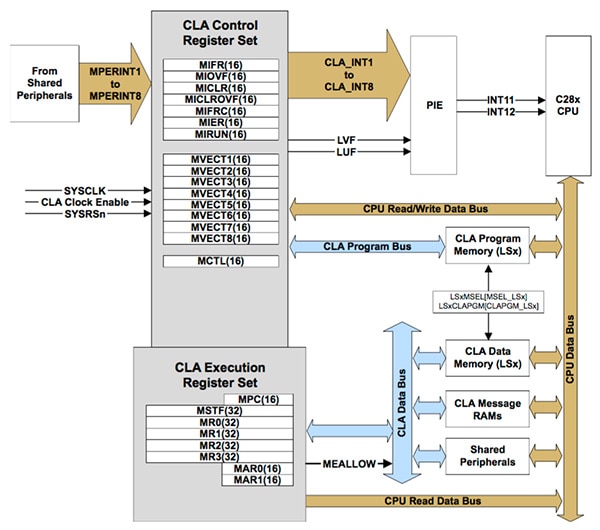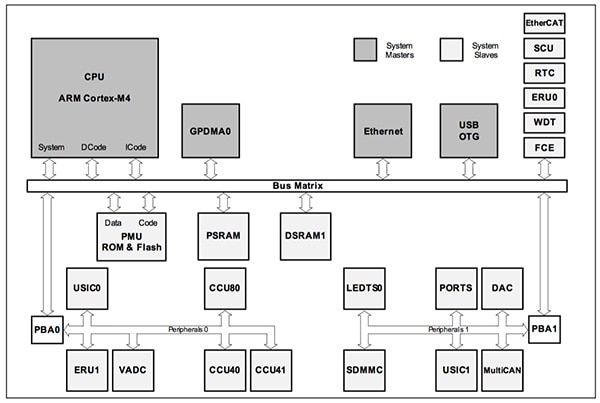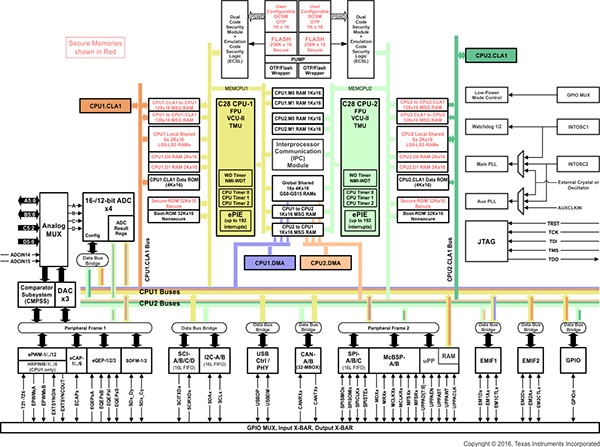Advanced Microcontrollers are Helping to Create a New Paradigm in Automation
Contributed By DigiKey's European Editors
2017-04-04
If there is any doubt that automation is now shaping everyday life, then look no further than Seattle’s newest store, Amazon Go. It’s a store that sells predominantly fresh produce like many others, but it has one fundamental difference: customers don’t need to take their products to a checkout in order to pay for them. They simply walk in, select the goods they want, and walk out.
According to the online retail giant, it has taken four years to get Amazon Go to this beta stage, and soon, the store will be open to all customers with an Amazon account and the relevant smartphone app. Customers simply swipe their phone screen as they enter and that’s it. Purchases are automatically billed to their Amazon account when they leave the store. The system is even able to detect when goods are replaced on the shelf.
This level of automation is unprecedented in consumer outlets today, but will likely be commonplace within a few short years. And it isn’t going to stop there.
Getting closer to the edge
According to Amazon, the technology deployed in its Seattle store was born from the same technology now being integrated into autonomous vehicles: deep learning, machine vision and sensor fusion.
As the IoT extends to the industrial, medical, automotive and retail sectors, the cloud becomes increasingly important. Much of the processing will undoubtedly be taking place in Amazon’s cloud service, but there are a growing number of cloud service providers offering similar technologies. Microsoft is perhaps the biggest competitor to Amazon in this respect with its Azure platform, but many more are already successfully providing cloud-based services to industries, including autonomous car manufacturers.
Automation is likely to spread, and in many ways, is going to be more significant than the IIoT, or so-called Industry 4.0 where industrial automation is streamlining the manufacture of many of our everyday goods.
Amazon Go has already been criticized for using technology to replace people at the checkout, but the harsh reality is that the next step will likely be robots able to replenish the shelves. While this may put greater pressure on the employment market, it will undoubtedly see the workforce moving to positions that are more skill based and less easy to automate. This level of automation may be set to change society, but it is going to require an even higher level of local processing. This is creating demand for Edge Processing, or what has become known as Fog Computing.
One of the unavoidable penalties of putting information in the cloud is the latency it introduces. In the IoT in general, and in automation in particular, latency is a big issue. Take home automation for example. If there is a noticeable delay between flicking a light switch and a light coming on, consumers will be less inclined to adopt it. In situations where automation involves physically autonomous objects like a shelf filling robot, latency could render the robot’s use untenable.
For this reason the same technologies that now enable Amazon Go and autonomous vehicles, will need to be implemented at the edge, whether in a local gateway in terms of Fog Computing or in the device itself.
Latency is introduced by bandwidth limitations as well as processing speed, so putting these technologies close to the edge has many benefits. Because of this it is now being actively addressed by many leading semiconductor vendors.
Multicore control
Embedded control is something microcontrollers have been doing for decades, and while the definition of ‘automation’ may be evolving rapidly, configurable devices have always been at its core. Today, more highly integrated devices are targeting this application space in response to the increased levels of automation across all sectors.
The TMS320F2837xD range of microcontrollers, part of Texas Instruments’ Delfino™ family, adopts a multicore architecture to deliver unprecedented performance in closed-loop control applications. Closed-loop control is a fundamental part of industrial drive systems and plays a crucial role in automation. The more efficiently complex control algorithms can be executed, the greater control is established over the system. As control is paramount for automation systems, the higher the compute performance the better. Granted, high performance always has tradeoffs, therefore semiconductor vendors are striving to develop devices that push performance at the architectural level, as is the case with the dual-core Delfino devices.
Although described as dual-core microcontrollers, it would be more accurate to refer to them as multicore devices. They feature dual real-time control subsystems based on TI’s 32-bit C28x floating point units, capable of running at 200 MHz (Figure 1 shows a block diagram of the TMS320F2837xD). Each of these subsystems has an independent real-time 32-bit co-processor, known as the Control Law Accelerator, or CLA. Each CLA is capable of concurrent execution, also at 200 MHz, and as such can effectively double the performance of each subsystem. This also allows time-critical functions to be offloaded to the CLA, leaving the main core free to execute other functions.
Figure 1: The dual-core Delfino from Texas Instruments uses architectural innovations to increase real-time performance in control and automation applications.
Each CLA features its own bus structure and pipeline (see Figure 2), and can execute one of up to eight specific tasks. Each of the tasks is completed in order of priority before the next task is initiated. Tasks can be triggered either in software or by a peripheral.

Figure 2: The Delfino’s Control Law Accelerator co-processor can double the performance of each of its subsystems.
Each subsystem features other architectural innovations including a Trigonometric Math Unit (TMU) and Virterbi/Complex Math Unit (VCU-II). The TMU accelerates algorithms with trigonometric operations as used in transforms and torque loop calculations, while the VCU accelerates the calculation of complex functions often used in encoded applications.
The device also integrates 24 PWM channels with enhanced features and 16 high-resolution PWM channels. These peripherals are ideal for implementing multi-axis drives and sensored FOC (Field Oriented Control) of 3-phase permanent magnet synchronized motors, for example.
As a part of TI’s C2000 family of microcontrollers, the dual-core Delfino devices are supported by the controlSUITE™ software environment, which includes libraries of code for implementing motor control, digital power, solar energy and LED lighting applications.
Real-time communications
Automation at any level relies on a high-speed communications interface between the different parts of a distributed system. The interface and protocol widely used to deliver this is EtherCAT®, or Ethernet for Control Automation Technology. EtherCAT was introduced in 2003, before the IoT or Industry 4.0 emerged. Nevertheless it has become an enabling technology for both. Fundamentally it provides short cycle times, low jitter and accurate synchronization, making it ideal for robotics, manufacturing and automated assembly systems. Its single master, multiple slave topology is intended to guarantee real-time performance, with a theoretical data rate in excess of 100 Mbit/s.
Many microcontrollers now integrate aspects of an EtherCAT interface, but only one family claims to be the first to have integrated a complete EtherCAT node on an ARM® Cortex®-M4-based microcontroller, the XMC4000 series from Infineon. Specifically, EtherCAT is integrated in the XMC4300 and XMC4800 members of the family.
As shown in Figure 3, the XMC4300 features a number of communication modules alongside an EtherCAT slave interface, including Ethernet MAC, USB, CAN and UART. A number of the peripherals have been added specifically to support industrial control and include the Capture/Compare Units, a Watchdog Timer, a Die Temperature Sensor, a Real Time Clock module and a System Control Unit.
The XMC4300 is also capable of running all of the major EtherCAT protocols in parallel, including Standard EtherCAT, Safety over EtherCAT and Ethernet over EtherCAT.

Figure 3: The XMC4300 from Infineon is the industry’s first microcontroller to integrate a complete EtherCAT node.
The XMC4300 and XMC4800 parts differentiate themselves against competitors’ devices by their level of integration. Specifically, the XMC4300 integrates all memory and clock generation needed to support EtherCAT, while competitive parts may need external memory, a quartz clock generator or both. This level of integration can significantly reduce the BoM cost, PCB area and design complexity. Infineon also highlights the inclusion of mixed signal peripherals available in the XMC4300 in the form of two 8-channel, 12-bit ADCs, and a two-channel, 12-bit DAC.
Another advantage of this device is its high bandwidth 32-bit bus connecting the EtherCAT IP to the CPU. This compares favorably with a discrete solution using an external microcontroller, which would consequently limit the bandwidth of data transfer, often to an 8- or 16-bit interface.
Conclusion
Innovations like deep learning, machine vision, and sensor fusion are creating a new paradigm in the industrial, medical, consumer and automotive markets. Advanced and highly integrated microcontrollers are now capable of combining the fundamental control and automation functions of that paradigm in a single device, targeting a wider range of applications.
Cloud-based services will be increasingly complemented by Fog Computing and processing at the edge. Devices like TI’s dual-core Delfino family and Infineon’s XMC4300 will drive further innovation and support even wider automation.

Disclaimer: The opinions, beliefs, and viewpoints expressed by the various authors and/or forum participants on this website do not necessarily reflect the opinions, beliefs, and viewpoints of DigiKey or official policies of DigiKey.










